Aliens, SETI, and the legacy of Frank Drake: 1930-2022
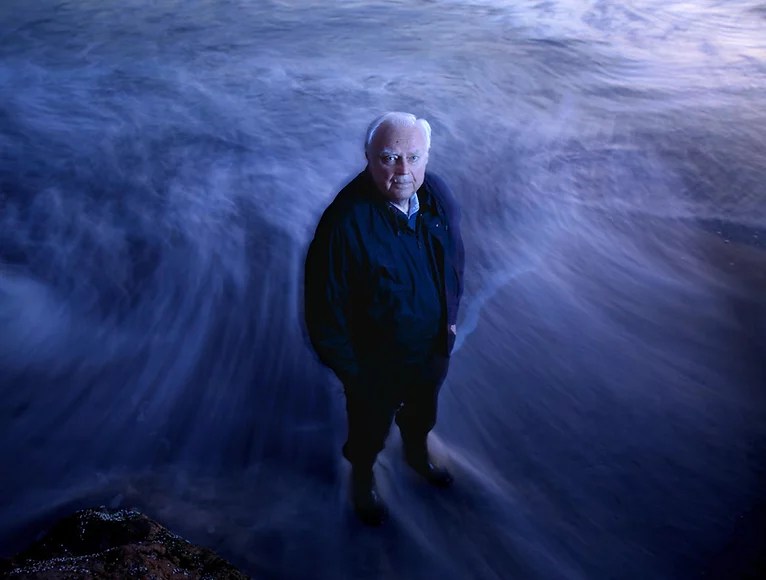
- Perhaps the biggest question we’ve ever asked about existence is whether we’re alone or not: are there any other intelligent, technologically advanced civilizations out there besides us?
- Where might the aliens be? Are they just unwilling to contact us? Do they even exist? The only way to truly find out is to scientifically search for the true answer, whatever it may be.
- The person who transformed the search for extraterrestrial life and intelligence into a science was Frank Drake. He passed away on September 2, 2022 at the age of 92. Here’s what he left behind.
Throughout human history, each time we’ve looked upward toward the night sky’s glittering canopy of planets, stars, the Milky Way, and more, we haven’t been able to stop ourselves from wondering just what might be out there. Were there other stars like the Sun, other worlds like the Earth, and other living, intelligent, self-aware beings, perhaps not so different from humans, in this vast Universe we inhabit? As astronomy and astrophysics developed as sciences over the centuries and millennia, our knowledge of what’s out there has increased tremendously, but our wonder at the possibility of life beyond Earth has never waned.
In 1950, famed physicist Enrico Fermi wondered aloud, “But where is everybody?” In 2022, this question – now known as the Fermi Paradox – still weighs on our collective minds without a definitive answer. But less than a decade after Fermi posed his question, scientist Frank Drake set about to transform this question from a philosophical one into a scientific one. He became the first person to begin searching for signals of technologically advanced alien life, pioneered the Search for Extraterrestrial Intelligence (SETI), designed the first message to be broadcast from humanity to any curious aliens who might be listening, and put forth the first method for estimating the number of intelligent alien civilizations that might be out there, right now, for us to communicate with: the Drake Equation.
On September 2nd, 2022, Frank Drake died at the age of 92, after a glorious career that revolutionized his field, but with humanity still yet to make our first discovery of life beyond Earth. His legacy will remain with us for generations to come, and we’ll all have him to thank when we first do discover extraterrestrial life – or even extraterrestrial intelligence – for the very first time.
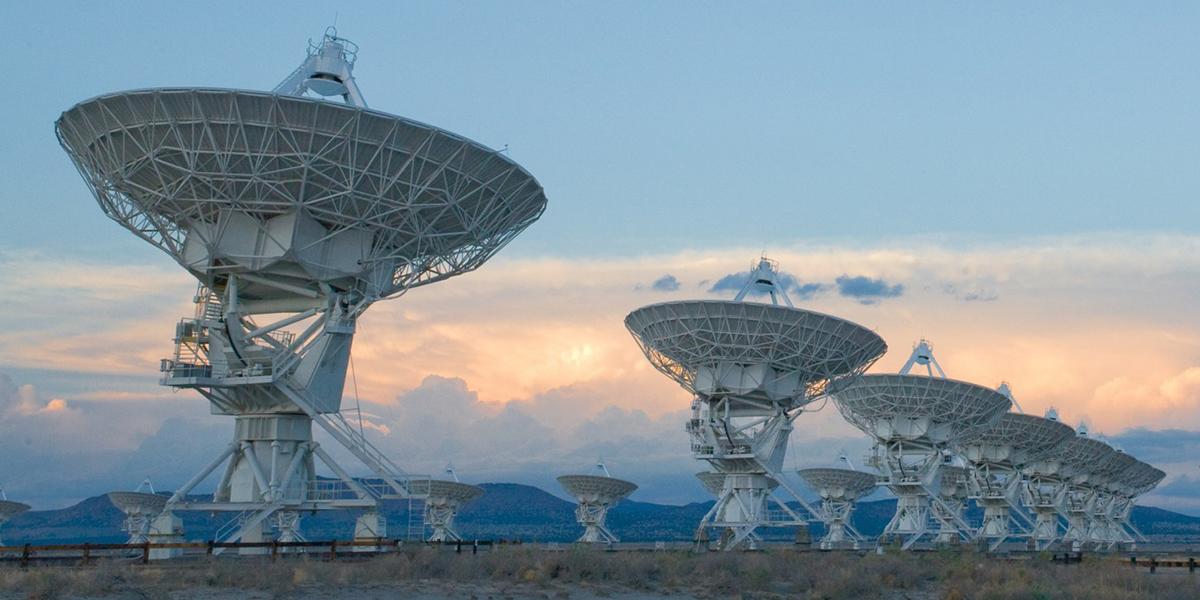
Drake was the first to realize the power of radio astronomy for interstellar communications between intelligent civilizations. Of all the signals that propagate through the Universe, none travel faster than photons: the massless particles that compose all the forms of light in the Universe. Traveling at the speed of light in a vacuum – and interstellar/intergalactic space is the best vacuum in the known Universe – the only means of communication that are comparably fast are gravitational waves and cosmic neutrinos: both of which are far more difficult to detect.
Light comes in many different wavelengths; not just the visible light our eyes are well-adapted to see. There are shorter wavelengths: ultraviolet, X-ray, and gamma-ray light, all of which possess greater amounts of energy-per-photon than visible light does. On the longer-wavelength side, there’s infrared, microwave, and radio waves, with longer wavelengths corresponding to lower energies-per-photon. In the case of radio waves, you can create over one million photons in that frequency range for the same amount of energy it would cost you to create a single visible light photon. It’s possible to encode a tremendous amount of information in radio signals by expending very little energy relative to every other option.
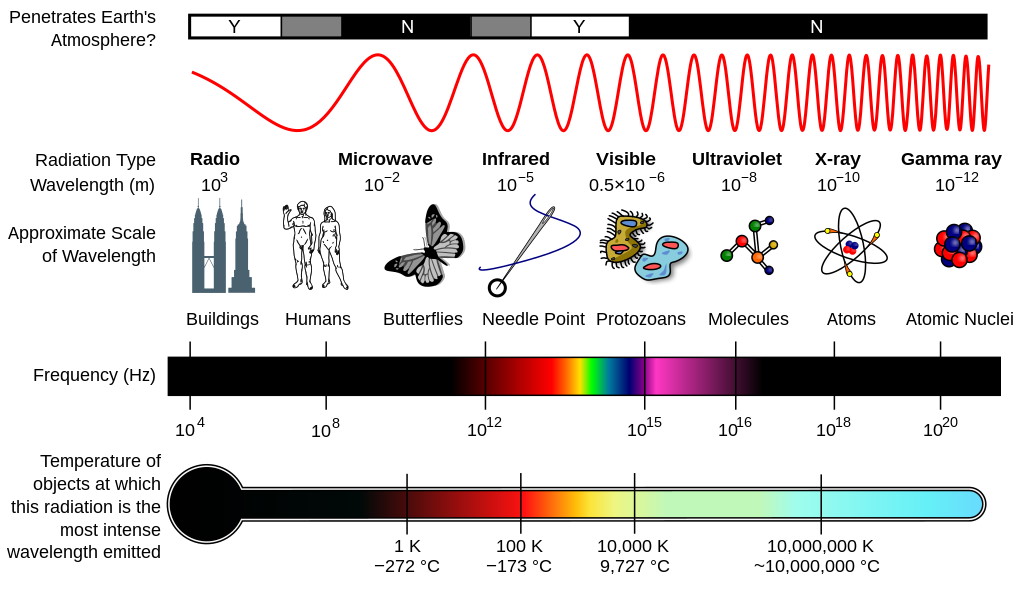
Although natural radio signals are copious throughout the Universe, Drake realized that a technologically advanced alien civilization could deliberately create an unambiguous signal that announced, “We are here, and we are not natural.” Things like mathematically recognizable pulse patterns, video or audio signals, and other types of encoded information could be teased out of any received radio signal, limited only by the imaginations and technological limitations of the alien species that chooses to make such a broadcast.
Drake became the first to recommend and conduct a systematic survey of objects-of-interest in the sky, searching for such intelligent alien signals. Although numerous candidates have emerged over time, none remain that cannot be explained through natural, astrophysical processes. Today, endeavors such as the Search for Extra-Terrestrial Intelligence (SETI) continue Drake’s legacy, scouring the full suite of radio data from the Milky Way galaxy and beyond for any signals that might emerge as deliberate, intelligent creations.

Drake also envisioned the possibility that perhaps, after thousands or millions of years, or even longer periods of time spent announcing their presence to the Universe, intelligent aliens within the Milky Way had simply given up on the possibility that anyone was out there. Perhaps it was even possible that our terrestrial civilization, here on Earth, was the most advanced species at the moment. If so, he realized, it would be up to us to be the first to announce our presence to others: engaging in an effort known as either “active SETI” or METI: Messaging Extra-Terrestrial Intelligence.
Drake realized that an incredible amount of power – at least, relative to the power typically used for radio broadcasts on Earth – would be needed to create a message that could be received by a civilization lying across the vast interstellar expanse. When the Arecibo telescope in Puerto Rico was completed, Drake designed what’s now known as the Arecibo message: a simple signal containing only a couple of hundreds of bytes of information, but one that was unmistakably intelligent in nature. Filled with information about who, what, and where we were, along with a mathematical “code of instructions” for understanding this message, it was the first time we ever deliberately broadcasted a message intended for an intelligent extraterrestrial observer.

But arguably the most enduring contribution Drake ever made to the field of science was through the equation that now bears his name: the Drake equation. The question of Fermi, “But where is everybody?” carries with it three assumptions.
- That aliens are not, and have never been, present on Earth.
- That if intelligent life is common throughout the galaxy, then it should only be a matter of time before one civilization technologically advances to the point where they’ve explored the entire galaxy, and should have made “contact” with us by this point.
- And therefore, something is wrong, or at least puzzling, about our line of thinking and the conclusions we’re drawing.
Where was the flaw in this argument? Is intelligent life exceedingly uncommon, perhaps? Could life be intelligent, but the challenges of interstellar exploration are simply too great – regardless of technology – given the constraints imposed by the laws of physics? Are humans simply too primitive, too uninteresting, or too flawed for anyone to want to make contact with us? Both before and after Drake, ideas such as this were floated as possible resolutions to the Fermi Paradox.
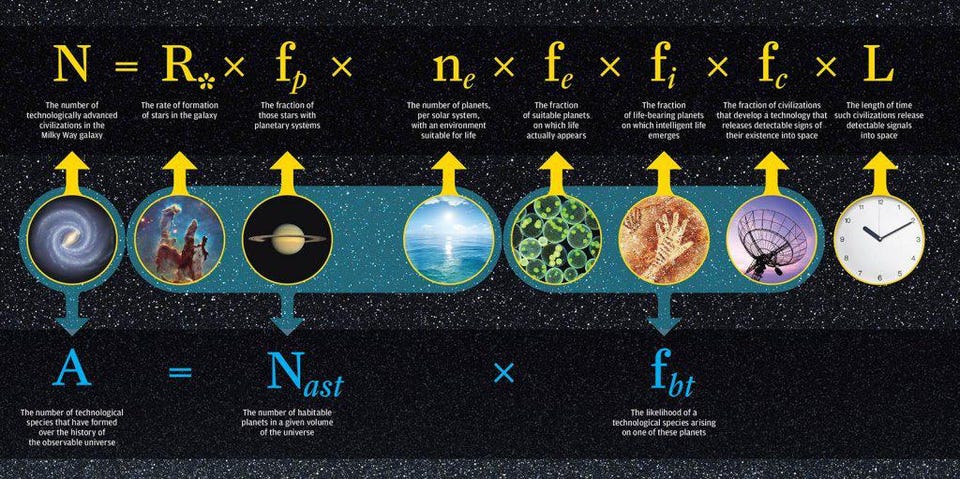
Drake’s approach was revolutionary. To simply ask, “Where are all the aliens?” is too detached from something we can hope to measure today, with current technology. Instead, Drake took the approach of breaking such a complex question up into smaller, more digestible components. Each one of those smaller questions could potentially be answered in a scientific fashion, but each answer would inch us closer to the overall goal of understanding what our expectations ought to be for formulating an accurate estimate for the number of civilizations that are out there, right now, for us to communicate with.
Drake’s breakdown stated that if you multiplied:
- the star-formation rate (number of new stars formed per year), which he assumed was constant,
- by the fractions of stars, overall, that possessed planets,
- by the number of Earth-like (i.e., potentially habitable) planets around each planet-possessing star,
- by the fraction of those planets where life actually does arise,
- by the fraction of living planets where intelligent life arises,
- by the fraction of intelligent-life-having planets which reach the level of technology necessary to receive and send interstellar communications, and which engage in that endeavor,
- by the amount of time that such a civilization exists, on average, before going extinct,
you’d wind up with a number that reflected how many intelligent civilizations were out there, right now, for humanity to communicate with.

The remarkable advance of this approach is easy to see. Yes, it’s true that, in the absence of knowledge of every single one of these terms, it’s impossible to make a precise, accurate estimate for how many intelligent extraterrestrial civilizations are out there. But by breaking a large, complex problem into smaller, more digestible components, the Drake equation gave us a systematic way to begin investigating the various factors that influence how many extraterrestrial civilizations are out there, as well as how many “partial successes” there are out there for each such step along the way.
There should, for example, be many planets out there around stars with conditions that could have led them to be potentially Earth-like: where the raw ingredients and plausible conditions for life to emerge are present, something we could uncover through the endeavor of astronomy alone. There should be many instances of inhabited planets out there in the galaxy and the Universe – where life emerged from non-life – irrespective of how complex, differentiated, or intelligent that life ever became. And even if there are only a few intelligent civilizations (maybe even as few as one) around in today’s Milky Way, there may have been many others in the past, who have simply gone extinct through either natural means or due to self-destruction.

Sure, it’s easy to point out numerous flaws and oversights in the Drake equation given today’s understanding of the Universe. For example, the star-formation rate changes over the Universe’s history, as does the fraction of stars that form with planets around them; this is inevitable in a Universe that began with a hot Big Bang a finite amount of time ago, and came into existence without the heavy elements needed to form rocky planets like Earth or the raw ingredients for life.
But Drake had no way of knowing this; when he first formulated his equation, the critical evidence supporting the hot Big Bang as the preferred idea for our cosmic origins – the Cosmic Microwave Background – had not yet been discovered. Today, we can make much better estimates of the number of potentially Earth-like planets that are out there, and we can be more granular about it: how many of them are around stars of each of the various sizes, masses, lifetimes, and metallicities (i.e., with specific fractions of heavy elements relative to the amount we have in our own Solar System) that stars and stellar systems come in? Today, these numbers are calculable.
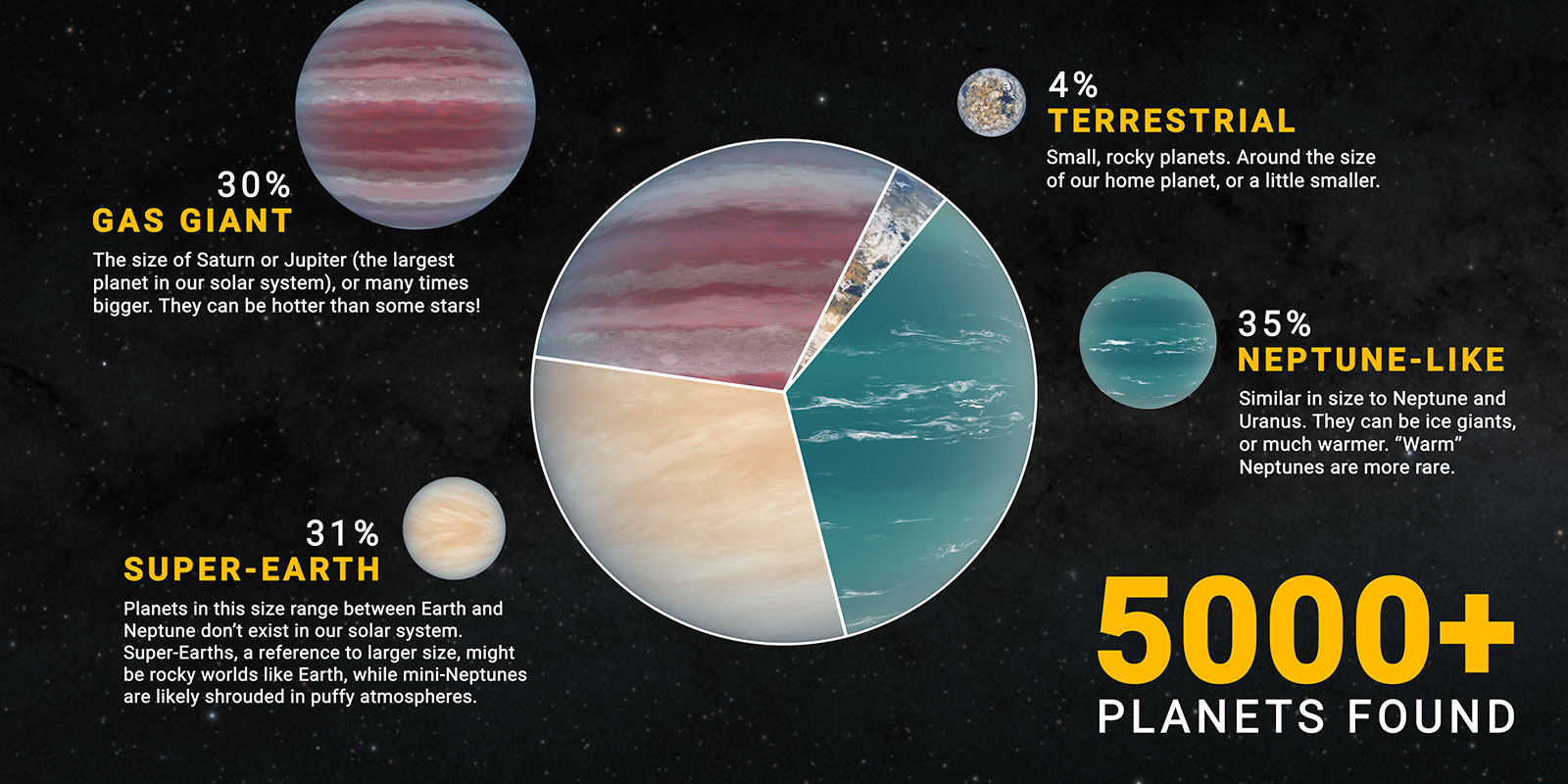
The idea and the approach recommended by Drake, however, have endured, even if some of the specifics that he put forth have since evolved. Today, scientists are taking a three-pronged approach in their attempts to reach the one milestone Drake always dreamed we would someday attain but never lived to see: the discovery of alien life beyond Earth.
- Exploration of the worlds in our Solar System. Is there dormant or fossilized life on a once-wet Mars? Does life exist high in the Earth-like conditions found in Venus’s cloud-decks? Could there be life around the hydrothermal vents at the bottoms of sub-surface oceans on moons like Europa or Enceladus? If life is common in the Universe, “interplanetary paleontology” might lead to its discovery.
- Searches for biosignatures on exoplanets. Visible signatures exist that Earth is inhabited. The continents green-and-brown with the seasons; CO2 levels rise-and-fall annually; our oxygen-rich atmosphere was created by life; the presence of chlorofluorocarbons reveal humanity’s presence. With advances occurring in the astronomical fields of transit spectroscopy and direct planetary imaging, this is perhaps our best hope for finding alien life in the coming decades.
- Continued searching for extraterrestrial intelligence. And yet, SETI could still succeed. If signals from intelligent aliens are out there – either via radio signals or from any other method of communication – we remain open to the possibility of finding something spectacular so long as we continue pushing the frontiers of how and where and when we monitor the Universe.
Although it hasn’t happened yet, the possibilities for success are continuously increasing with each and every scientific and technological advance we make on every one of these fronts.

Today, thousands of scientists worldwide are active in the hunt for extraterrestrial life and extraterrestrial intelligence. Although we cannot know how or when it will happen, the day will no doubt come in the not-too-distant future where we discover the presence of life beyond planet Earth for the very first time. Perhaps it will be primitive and rare, found on a world or a fragment of a world here in our own Solar System. Perhaps there will be overwhelming indirect evidence arriving from an exoplanet orbiting a star many light-years from our own. Or perhaps we’ll detect it because we looked at or listened to or put a message out into the Universe in just the right way, and discovered that we weren’t “alone” as intelligent, technologically advanced life forms, after all.
One thing, however, is certain: we’re no longer reliant on aliens coming to Earth and announcing their presence to us if we hope to discover them. Instead, the search for life beyond our planet – including intelligent life – is now firmly a scientific endeavor, and Frank Drake was the person who brought that transformative leap to our civilization. May we honor his legacy by bringing his ultimate dream to fruition, and continue to search for the answer to perhaps the biggest existential question of all: who else is out there in the Universe?





